Holiday Gift Suggestion: Car Seats For Dogs – PUPSAVER Releases the Petite Version!

Evenings hanging in my Pupsaver Petite. Now, I can go everywhere with mom!
** THIS POST WAS UPDATED ON DECEMBER 8, 2017 **
This is such an important topic, I’ve updated a 2014 post with fresh info. I am not an affiliate of Pupsaver; I’m a big fan of the product and the family who created it.
Bark Bites for those on the go. The full scoop below.
* Statistics show that driving with a dog unrestrained is dangerous and causes more accidents. In some states, it is illegal.
* An unrestrained 10-pound dog in a crash at 50 mph will exert 500 pounds of pressure; an 80-pound dog at 30 mph will exert 2400 pounds of pressure. That kind of force can do an enormous amount of damage to the dog and to human passengers.
* PUPSAVER is the only car safety seat for dogs tested by a National Highway Transportation Safety Administration-approved lab, MGA Research Corporation, to the rigorous standards and FMVSS-style crash tests required by the Federal Government for infant safety seats, for dogs up to 45 lbs. The only one.
* It was invented by Ray Bennett, a 40 year veteran of the automotive industry, along with an industry colleague, a veterinarian and an engineer from Georgia Tech.
* Veterinarian Dr. Kelly Trogdon, of Faithful Friends in Cumming, Georgia, emphasized, “Nothing on the market resembles the Pupsaver ™. The Pupsaver ™ is unique because it cushions dogs in the event of a crash (or sudden stop). But even more importantly, it absorbs the unpredictable impact of a deployed airbag, which could injure or kill a little dog riding in the front seat.”
* It is easy to install in your car and easy to transport.
* It is only for dogs up to 45 lbs. For heavier/larger dogs, the Sleepypod Clickit 3-Point Harness System is very highly rated as the best on the market.
* The leopard print is really cute and comes with a cherry red trim, but there are other great choices, too.
* And just out, they offer the Pupsaver Petite, for dogs up to 10 lbs., like our Chi’s and other tiny dogs!
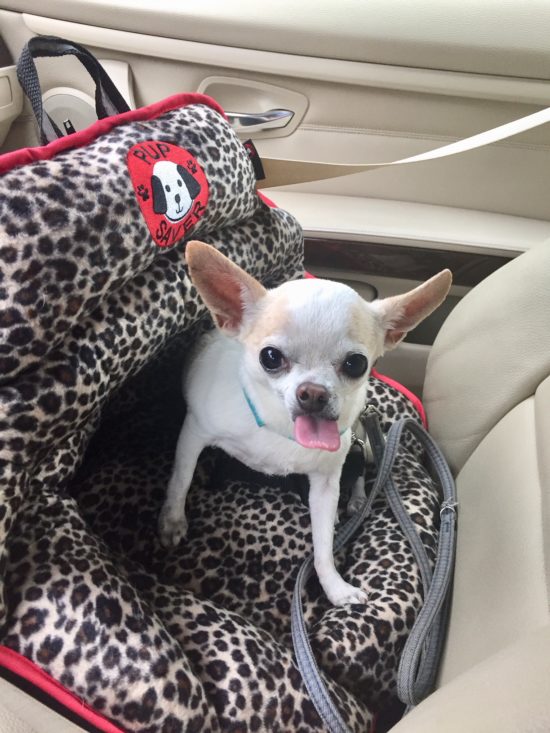
Who’s the wise guy? Albie keeping it real in his Pupsaver Petite: cute & safe!
♥ ♥ ♥ ♥ ♥
Sophie doesn’t like car seats. I’ve tried; I really have. We have a veritable safety seat graveyard in our garage of those that just didn’t work out. But, then I saw this one. I admit, it is darn cute and that is what first attracted me. C’mon! Plush leopard fabric with cherry red trim? Nice! And it looked so cozy, like a cushy pod. So, despite my husband shaking his head and I’m sure thinking to himself, here we go again, I checked it out. I’m really happy I did! The PUPSAVER is the first car seat Sophie likes. The bonus is, it’s the only dog safety seat that’s been officially crash tested.
Now, PUPSAVER just released a petite version, good for tiny dogs up to 10 lbs, which we use for our Chihuahua’s Anabelle and Albie. Car seats for dogs is a gift of love. No doubt about it.
Here’s why:
* Of the top 25 reasons for most car accidents, #1 is “being distracted.” 31% of the 1,000 dog owners surveyed by the American Automobile Association (AAA) acknowledged being distracted by their pets while driving.
* A whopping 59% said they’ve participated in at least one “distracting behavior” while driving with their canine companions, including allowing their dogs to sit on their laps: 21% (embarrassed to admit this, but I was one of those).
* 80% said they take their dogs with them on errands, going to the park, or on road trips, but only 16% acknowledged using any type of pet restraints.
* According to the American Pet Products Association, there are 78 million dogs in US households. 56% of those 78 million dogs are going for a ride at least once a month … that’s 43,680,000 dogs traveling in vehicles. And, only 16% are buckled up. That means 36,691,200 dogs’ lives are being put at risk every month.
* In some states, it’s the law: in Arizona, Connecticut and Maine, distracted-driving laws can be used to charge drivers with pets on their laps. In Hawaii, it is explicitly forbidden for drivers to be holding a pet on their lap. In New Jersey, an NJSPCA officer can stop a driver they believe is improperly transporting an animal. Tickets range from $250 to $1,000 per offense, and a driver can face a disorderly person’s offense under animal-cruelty laws. And, in Rhode Island, Democratic State Rep. Peter Palumbo has proposed legislation that would make having a dog in your lap a distracted-driving violation.
If you’re not yet convinced, one of the most disturbing facts, if not the most disturbing, is this:
“An unrestrained 10-pound dog in a crash at 50 mph will exert roughly 500 pounds of pressure, while an unrestrained 80-pound dog in a crash at only 30 mph will exert 2,400 pounds of pressure,” said Jennifer Huebner-Davidson, AAA National, traffic safety programs manager. “Imagine the devastation that can cause to your pet and anyone in the vehicle in its path. Restraining your pet when driving can not only help protect your pet, but you and other passengers in your vehicle as well.”
These are all very serious statistics. I wanted to know more about this product.
Ashleigh Bennett, along with her father, Ray Bennett, a 40-year veteran of the auto industry, own PUPSAVER. Ashleigh was kind enough to send me that cute leopard model to test out on Sophie. I warned her it could be a lost cause, but I was game, because I know I’d feel a whole lot more comfortable having Sophie properly restrained.
What Makes This Safety Seat Different?
I did some research and found some very compelling information.
PUPSAVER was evaluated in a crash test by an NHTSA-approved lab, MGA Research Corporation. MGA is an accredited third party lab that contracts with automobile, motorcycle, bus, aircraft, child restraint, military, manufacturers and consumer publications along with US and Foreign government agencies. In addition, MGA conducts FMVSS-style crash tests on canine safety products which follow the guidelines set forth by the federal government for child safety seats. A variety of PUPSAVER seats have now been tested at speeds up to 35 mph, with crash test dummies weighing up to 45 pounds. The results showed that the PupSaver seats contained the test dummies and maintained structural integrity under incredible force. It is the only dog car safety seat that’s been tested in this way; it is the only dog safety seat that can make this claim. Wow, that’s big.
How Does PUPSAVER Work?
The PUPSAVER attaches to the existing seatbelt system of your car. The lap portion of the belt attaches to the bottom and the long shoulder strap connects to the back of the PUPSAVER. The PUPSAVER, like an infant car seat, is rear-facing, and when you place your dog inside, its own collar or harness attaches to a short tether. Your pup is not attached to the automobile seat; only the PUPSAVER is. That makes a big difference and here’s why.
Hopefully, you’re still with me. If you have any questions, I’m happy to answer them in the Comments. Here’s the rest:
In a crash, and I don’t want to get too technical here, but there’s a feature in all cars over the last 20 years called a pretensioner. What it does is it causes the long shoulder strap of your seat belt to lock in place, simultaneous to when the airbag deploys. Its like the fail-safe feature of your seat belt on impact.
Because the PUPSAVER utilizes the long strap behind the seat, when it locks, either through a sudden stop in everyday driving or through the pretensioner firing in a major crash, it actually causes the PUPSAVER to pull over your dog like a catcher’s mitt, enveloping and, thereby, protecting the dog. And, because the PUPSAVER is secured to the car at its bottom and its back, it stays put; the dog, collar/harness and PUPSAVER all move together, if you get what I mean. They’ve really done something ingenious here.
The Company, The Design, The Crash Testing
I reached out to Ashleigh to answer more in-depth questions I had about the company and the seat. Ray, happy to talk, too, is much more technical in his explanations, so Ashleigh and I both felt she might explain things in more of a layman’s terms. I don’t know about you, but layman’s terms was good for me! 🙂
BaS: Ashleigh, how and why was the company formed?
AB: It’s basically the brainchild of my dad, Ray Bennett. About 6 years ago, he began taking his Lhasa Apso, Webber, in the car everyday as his lunch companion. He started to get really nervous. Webber was riding in the front seat (he refused to stay in the back) and was sliding around on the passenger seat. One particular day, my dad had to slam on the brakes hard to keep from hitting another car, and Webber just launched into the dashboard and fell to the floor. My dad took him to the vet, who said he was banged up, but ok. He was limping around the house and my dad felt like a terrible pet parent. He couldn’t bear the idea of ever doing that to the dog again, so he started researching trying to find a dog harness system for the car.
Ray Bennett, the creator of the seat, weighed in here, too.
RB: I invented the PUPSAVER when I realized I was putting my dog in harm’s way by allowing him to ride on the seat next to me, with nothing but hard surfaces to slam into when I was forced to stop quickly. It occurred to me, I would never allow a baby to ride in such a dangerous manner, and I immediately sought out all products available to provide protection….I bought harnesses etc., but those were not the answer for me. I realized that these small, fragile fur babies needs were much like an infant child, and I set out to emulate the rear facing infant safety seat for a small dog. The missing link had been the lack of any impact protection for my constant companion.
BaS: OK, makes a lot of sense. Did Ray develop this himself?
AB: He actually called up one of his auto industry buddies, a veterinarian and a Georgia Tech engineer he knows. They started doing testing using a rear-facing shell type seat, like an infant’s. What they found was that the most important thing in a crash is impact protection; keeping the animal on the seat.
BaS: How did the PUPSAVER develop; what was the process?
AB: Once they identified exactly what the seat needed to do, they added some cushion to the hard seat shell, which would lessen the impact and developed 3 or 4 prototypes. What they found worked best was to have the shell filled with a very dense fabric on the inside that was going to keep what’s called “bottoming out” from happening. That’s when, under extreme pressure, the weight of the child or the dog will go through to the bottom and come in contact with the hard surface. After 3 years of research, he got the final PUPSAVER made. That first one slid into the footwell because it was shown to be the safest place for the dog to be in a crash, based on car modifications made from lots of leg injuries in crashes back in the 60’s.”
But a footwell design didn’t allow for the seat to be formally tested. So, Ray and his team went back to the drawing board.
AB: They discovered MGA, the NHTSA’s facility for testing child safety seats. They learned that they had already developed, with the Center for Pet Safety, a test that mirrors the FMVSS213 test, which is the current industry gold standard for child safety seats. This tests the strength of the seat to make sure whatever’s inside of it stays contained and keeps the car seat from dislodging from the automobile seat.
AB: They started testing with MGA and, this past November, PUPSAVER passed the 25 lb test at 30 mph in a frontal collision, which represents 67% of all vehicle incidents. (THIS HAS NOW BEEN UPDATED TO A 45 LB PASSED TEST)
Remember, frontal collisions are where untethered pets will become like projectiles.
BaS: So, PUPSAVER is the only impact protection device crash-tested like a child safety seat, at a U.S.-based NHTSA facility?
AB: PUPSAVER was evaluated in a crash test by an NHTSA-approved lab, MGA Research Corporation. MGA is an accredited third party lab that contracts with automobile, motorcycle, bus, aircraft, child restraint, military, manufacturers and consumer publications along with US and Foreign government agencies. In addition, MGA conducts FMVSS-style crash tests on canine safety products which follow the guidelines set forth by the federal government for child safety seats. A variety of PUPSAVER seats have now been tested at speeds up to 35 mph, with crash test dummies weighing up to 45 pounds. The results showed that the PupSaver seats contained the test dummies and maintained structural integrity under incredible force. It is the only dog car safety seat that’s been tested in this way; it is the only dog safety seat that can make this claim.
Veterinarian Dr. Heather Loenser emphasized, “With all of the dangers on the road, I protect my entire family using car seats for my children and PUPSAVER for my dog. PUPSAVER has a proven track record, crash tested by the same company that tests children’s car seats. The rear-facing, catcher’s mitt design envelops your dog, eliminating the stress of a harness on impact.”
For me, there’s a lot of comfort in that. It’s easy to attach to your seat belt, too. And, if I say that, believe me, you can do it, too. I’m a total technically-challenged person.
BaS: But, why can’t we use a regular harness for our dogs in the car?
AB: When my dad was doing research into a solution for Webber, the crash tests for harnesses were really disturbing. Seven different harnesses were tested, using crash test dummy dogs. You see dogs flying off of the seat, they’re twisting up in the harnesses, it looks like their necks could be breaking, it’s just horrifying. If you’re a dog lover, it’s a really scary thing to see. They’ll even tell you that it’s very disturbing to watch, because you imagine, if this was a real dog, what would be happening to them in these harnesses. So, that was really his catalyst. He said, ‘I can’t have my dog in a harness like this.’ That’s when he decided this had to be a child safety seat for a dog. Nothing less would fit the bill.
I want to add here that, for dogs over 45 lbs, a three-point safety harness seems to be the best option out there, at this point. Traditional harnesses are not safe in a real crash. There’s a good one, made by a company called Sleepypod. Their Clickit 3-point Safety Harness is padded and seems to ground the dog much better than a traditional harness, because it attaches to the dog/seat belt in 3 separate places. What I have read is that it’s difficult for the dog to lie down with a 3-point harness system, and that is an issue for some dogs and, therefore, their owners. But a shorter tether is, actually, much safer. The longer the tether, the more velocity your dog has in a crash scenario, and the greater the force trauma on your dog. The Center for Pet Safety did a Sleepypod Clickit harness crashworthiness test, sponsored by Subaru of America, in which the product fared pretty well for larger dogs. You can see the videos here.
BaS: At our core, we are a living stylishly site, so I have to ask you about the great fabrics the PUPSAVER comes in. Who chooses them and does it follow trends?
AB: We look for very soft, yet durable material. We also did a focus group of women with small dogs and asked them what they would like to see. They unanimously agree that an animal print was a must. The leopard print has been a best seller for us. The black and white checkered pattern is good for boy dogs, too, although some like the leopard for boys. We’ve found that people want something whimsical when it comes to their pets, and many are drawn to the leopard.
It’s also easy to transport. It folds up and has handles for carrying.
I learned so much from talking with Ashleigh and doing my own research. When I first wrote this story, we only had Sophie. Now, I am beyond thrilled that Sophie and her siblings Jasper, Ani and Albie like their PUPSAVERS and go into the without any drama. Ashleigh thinks it must be something about the catcher’s mitt-like structure, that makes dogs feel safe. I also think it helps that Sophie can’t see what’s going on outside the car, as that was always a distraction for her that sometimes caused anxiety. But, most of all, I feel like my dogs are finally as safe as they can be in my car. And that kind of peace of mind is priceless.
Do you use a harness or a safety seat for your dog? What’s your thoughts? What’s your experience using these products for your dogs? Share your stories with me below. I’d really love to know.
A great holiday gift for your dog or a loved one’s.


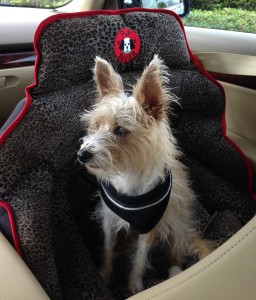



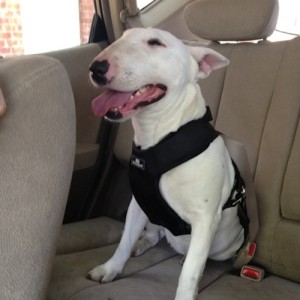

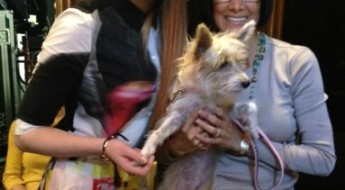
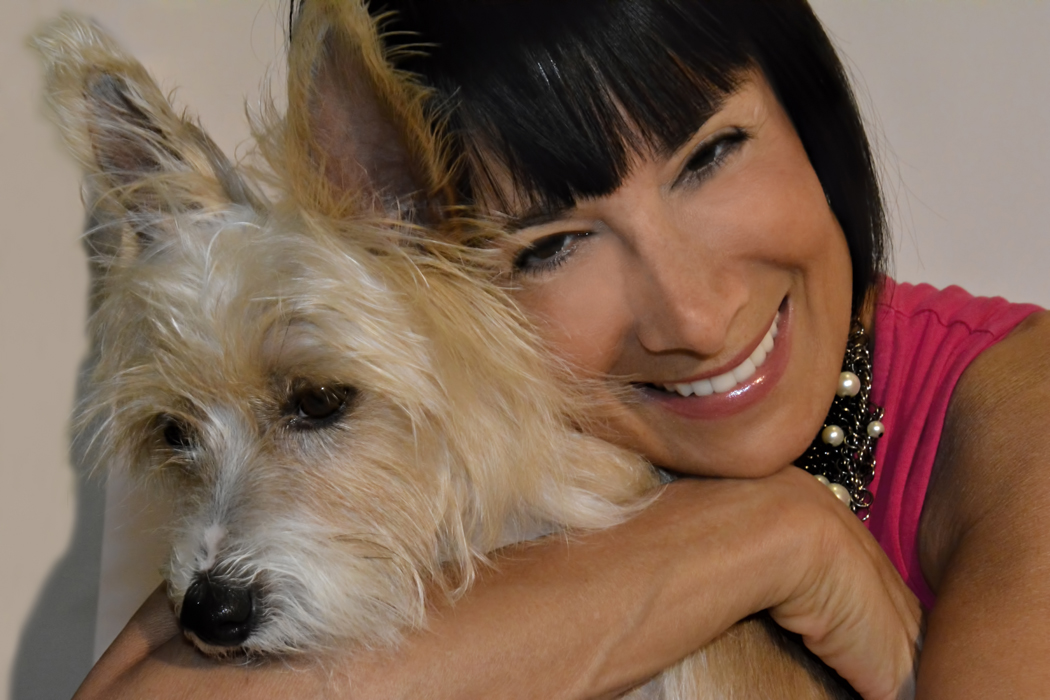

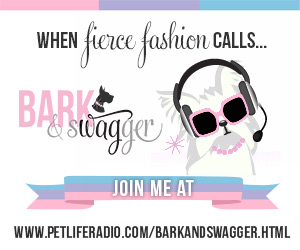
Hello, I tried the link provided for the special on the pupsaver but it shows the page can’t be found. Is this offer still valid? Thank you.
http://www.pupsaver.com/howtobuyspecial.php
Hi Sherry-checking with the manufacturer in the morning and will get back in touch then. It’s a fantastic car seat; so glad you’re getting one for your dog. We have two and I wouldn’t take them anywhere without it. Be in touch tomorrow morning. Thanks!
Hi Sherry – Spoke with Pupsaver and if you go to the site and put the promo code PARTNER in, you will get 10% off. Thanks for letting me know about the link, as I need to fix that now, too. 🙂 Jody
Thank you for the indepth report, i nneded the exact info to feel like I was making the right choices for my small Chi. All the places it seems to be selling at online don’t say who tested it. And all the rest of the info is just a bonus i have to say after not being that sure about the pupsaver, I now have falling in love with it thanks, I could have missed out just because it was not well showcased or lucking all the info I needed to feel it was truely what they said. I was worried about the plastic buckles and the fact that the harness is clipped to the bottom of the pupsaver seat not the seatbelt how strong is the part that anchors the dog to the pupsaver and how can it be safe for it to go on a collar? But it sounds like the pupsaver seat is right up their as one of the safest saets for smal dogs, it’s a great idea and I want one. Just one thing you bring up at the end that the sleepypod for large dogs; are great and are the only safe car harness for your bigger furbabys but I belive the kurgo Tru-Fit Enhanced Strength Harness 3055 series
Has been tested by the university of Michigan, national highway and transportation administration lab using (FMVSS) 213 for child restraint systems. They have a UT crash test video depict with a 50lb dog traveling at 30 miles per hour. And other test done All info on their page. And it was awarded the “Family Choice award” in 2014 for its safty. They have a lot of great reasons what makes them super safe and this is what I was compering the pupsaver too. I do have a lager dog as well that goes in the back of our 7seater. Know I’m thinking if I take this very safe harness and add it to the seatbelt that goes across the back of the car seat with the pupsaver will this be safe ?? Meaning the dog sets in the pupsaver and I uses the kurgo 3055 harness. And how do I get this in Austriala ?? thanks
Hi Jasmine – Sorry it took this long to get back to you! I’m so glad you found the post helpful. Thanks for giving me that info on the Kurgo Tru-Fit. I’m going to look into that more for sure. I’m not sure if you mean to use the Kurgo on your big dog and the Pupsaver with your small dog OR to use the Kurgo on your small dog inside the Pupsaver. Pls clarify. You don’t need the Kurgo inside the Pupsaver. The Pupsaver is designed to work with a collar or regular harness attached to its short leash. But the Kurgo sounds like a great option for a dog over 30 lbs. You can buy the Pupsaver online from my article. They ship all over the world. Hope this was helpful, Jasmine and pls feel free to reach out with any other questions. My email is jody@barkandswagger.com. Thanks! Jody
Your website is actually awesome. May I connect with you on G+.
Look at my site – sell your automobile
Glad you like, Patsy! Of course we can connect. Not interested in selling an auto. I live in NYC and don’t have one! 🙂
Wow, thank you so much for this great content!!
Hi Ethel! Glad you found it useful! It was a great learning experience.
I think it sounds like a fabulous product but one problem for us. Dakota will ONLY sit on the floor in the car. (Yep that’s the truth) He will NOT sit on the seat….not good I know, but this is our reality.
I hear you! Sophie wouldn’t sit anywhere but in my or her dad’s lap, which is probably worse. The footwell is the most protected part of the car, I learned, but yes, a loose dog isn’t a great thing. Maybe Dakota could get used to something slowly, with lots of treats or a great bone to chew while he’s in the seat? Just a thought.
Hey Bark and Swagger readers – here is the special promo link to use (enter the promo code once you have followed the link): Go to: http://www.pupsaver.com/howtobuyspecial.php 2) then enter promo code: PUPSAVERSPECIAL for $99.95 price and Free Shipping!
Any more specials?
Hi Joyce – for the Pupsaver in particular?
Not at the moment for Pupsaver, but for many other products in fashion, books and other things.